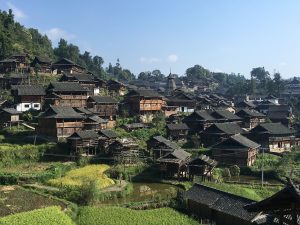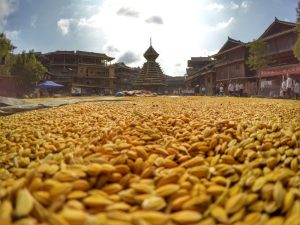Angelina Vong und Yong Mao
“Kommen Sie nach Kaili [Guizhou, China] und hören Sie Volkslieder aus aller Welt.” Lernen Sie die Volksmusik des Orients kennen, indem wir die Stadt Kaili und die umliegenden Dörfer kennenlernen und Volksmusik aus der ganzen Welt erforschen. Die IFCM freut sich mitteilen zu können, dass zeitgleich eine Weltkonferenz der Stimmen (World Voices Conference) stattfinden wird. Lesen Sie weiter, um mehr über die ethnische Minderheit der Dong, ihre Lieder, das Festival und die Konferenz zu erfahren.
Die Dong sind eine der fünfundfünfzig offiziellen chinesischen ethnischen Minderheiten und zählen etwa drei Millionen Menschen. Wie einige andere chinesische Minderheiten leben sie in benachbarten Provinzen in Südchina und haben ihre eigene Sprache und Gebräuche. Die Dong sprechen Kam, eine Sprache, die einem Zweig der Sino-tibetanischen Sprachgruppe zugeordnet wird, sie verstehen aber auch Mandarin.

Die drei Schätze der Dong
Diejenigen, die mit dieser ethnischen Minderheit nicht vertraut sind, werden finden, dass sie eine der interessantesten Volksgruppen in China sind, weil sie eine so reiche Kultur haben. Ein Großteil ihrer Kultur dreht sich um Gesang und Tanz. (Die Dong sind auch als Kam, Tong oder Tung bekannt). Zu den „Drei Schätzen” gehören die Großen Gesänge, eine besondere Form der Volksmusik.
Die Dong etablierten sich entlang der Flüsse und Stauseen. Die Großen Gesänge – Al Laox oder Dong-Chorgesang – sind eine einzigartige, in dieser Volksgruppe weit verbreitete Tradition des Volksgesangs. Al Laox bedeutet große und alte Gesänge und ist a cappella. Die Gruppen selbst sind klein, aber jeder Sänger spielt eine wichtige Rolle: alle müssen ein ausgezeichnetes Gehör besitzen. Die meisten von ihnen werden von den Eltern oder Großeltern von Kindheit an hart trainiert. In den meisten Fällen werden diese A-cappella-Gruppen innerhalb einer Familie gebildet, wobei Familiengeschichte, Gedichte und Geschichten von einer Generation zur nächsten weitergereicht werden.
Die Großen Gesänge enthalten oft verschiedene Rhythmen, elegante Melodien und wunderschöne Texte mit tiefer Bedeutung. Die Texte verwenden zumeist Metaphern und Analogien, um Liebesgeschichten und solche über Beziehungen, Freundschaften, Natur und harte Arbeit zu erzählen. In den Großen Gesängen, die die Natur nachahmen, sind manchmal auch Klänge von singenden Vögeln, plätschernden Bächen oder zirpenden Grillen zu hören. Große Gesänge sind in Kategorien für unterschiedliche Gelegenheiten aufgeteilt und werden je nach Zeit, Ort und Anlass gesungen.
Wie gesagt, wird die Musik der Dong seit über tausend Jahren von Generation zu Generation weitergereicht. Sie hilft der Volksgruppe, ihre Kultur zu bewahren, sich als Volk zu fühlen, Gefühle auszudrücken und sogar bei romantischen Verabredungen. Es gibt in ihrer Sprache kein spezielles Wort für Musik, eine Tatsache, die vielleicht dafür steht, welch zentrale Bedeutung sie in ihrem Leben hat: Singen und Musizieren liegt ihnen einfach im Blut, es ist ihre Sprache und ist zu einem Synonym für sie geworden. Die Instrumentalmusik hat sich als ein Anhang der Vokalmusik entwickelt. Fast alle gespielten Instrumente haben etwas mit Gesang zu tun.
Die Trommeltürme der Dong werden ganz natürlich zum Ausdruck für die musikalischen Talente der Dong bei ihren Festen. Dongfeste finden das ganze Jahr über statt; sie sind eine Gelegenheit für Wettstreite für Gesang, Tanz, Opernspiele, Wasserbüffel- und Vogelkämpfe, sowie Hochzeiten, Rituale und sonstige Zeremonien. Ein alter Brauch besteht darin, dass am Vorabend eines Festes junge Männer ausgehen und unverheiratete junge Mädchen aus benachbarten Dörfern einladen. Diese eingeladenen Mädchen tragen wunderschön gewebte und bestickte Kleider und handgemachte silberne Armreifen; sie haben Flöten oder Trommeln dabei. Sie folgen den jungen Männern in deren Dorf, wo sie in den Trommeltürmen zusammen ein reiches Mahl einnehmen. Sie sitzen sich in parallelen Reihen gegenüber, und nach dem Essen singen sie sich gegenseitig ihre Lieder bis zum Morgengrauen vor, um sich kennen zu lernen. Dabei kommen auch Flöten, Pipas, Trommeln und andere Instrumente zum Einsatz. Am nächsten Morgen kehren die jungen Mädchen in ihr eigenes Dorf zu ihrem Trommelturm zurück. Man sieht, dass das Singen bei der Umwerbung des anderen Geschlechts eine wichtige Rolle in ihrem Leben spielt.
Die Dong sind äußerst geschickte Zimmermannsleute. Das zeigt sich in den einzigartigen bedachten Holzbrücken, einem einzigartigen kulturellen, staatlich geschützten Erbe. Diese öffentlichen Brücken sind wunderschöne große Konstruktionen, die in und um die Dong-Dörfer herum zu finden sind. Sie sind unter dem Namen Wind-Regen-Brücken bekannt. Diese Brücken und Dörfer sind so attraktiv, dass ihr Besuch einfach begeistert. Ein Dong-Dorf kann mehrere solche Wind-Regen-Brücken besitzen; sie sind mit speziellen Aufbauten versehen, um die Menschen vor Wind und Regen oder sonstigem ungünstigen Wetter zu schützen, oder um sich auszuruhen. Es handelt sich um kleine pagodenartige Pavillons mit reizvollen Dekorationen, die direkt auf die Brücken gebaut sind. Einige darunter sind zu Tempeln geworden. Im südlichen Teil des Siedlungsgebiets der Dong gibt es kleine exquisite Brücken, Blumenbrücken genannt, die mit geschnitzten Drachen und Phönixen verziert sind. Manchmal sind diese einfach direkt auf den Boden gebaut, ohne einen Fluss zu überqueren. Die Pagoden dienen den Dong nicht nur zur Anbetung ihrer Götter, sie ermöglichen auch das gesellschaftliche Zusammensein, Vergnügungen oder ein romantisches Treffen im Mondlicht.
Man nimmt an, dass die meisten Konstruktionen der Dong im Geiste der uralten chinesischen Philosophie des Feng Shui gebaut sind, wörtlich Wind-Wasser. Die Kraft des Feng Shui harmonisiert und gleicht alle Elemente in der nahen Umgebung aus, das ist ein wichtiges metaphysisches Prinzip der Chinesen. Es wird als selbstverständlich erachtet, dass die Wind-Regen-Brücken so gebaut sind, dass sie alle Bedingungen des Feng Shui erfüllen, einschließlich der Wahl der Stelle, wo sie stehen, um das Schicksal des Dorfes günstig zu beeinflussen.

Der Schutz des Dong-Erbes
Die Großen Gesänge der Dongchöre (Grand Songs of Dong Chorus) wurden zuerst 1986 bei einem Musikfestival im Chaillot-Nationaltheater in Paris im Jahre 1986 international bekannt. Es war das erste Mal, dass die polyphone Musik der Dong außerhalb von China gehört wurde. Seit 2005 gehört die Tradition zum Nationalen Immateriellen Erbe Chinas und steht seit 2009 auf der Liste des Immateriellen Weltkulturerbes der UNESCO. Es ist ermutigend, dass dieser Gesang als schützenswert klassifiziert worden ist. Die chinesische Regierung hat verstanden, dass diese fragile orale Tradition der Dong dringend geschützt werden muss. Das Dorf Xiaohuang ist der berühmteste Versammlungsort für die Großen Gesänge. Deshalb wurde es als Standort für das Dong Chorus Museum gewählt. Die Fertigstellung des Museums hat eine wichtige Rolle für die Festigung der kulturellen Identität der Dong gespielt und den Sinn für ihren kulturellen Schutz geschärft.
Die Dong haben die Traditionen ihres Volkes durch ihren Gesang über 2500 Jahre weitergereicht. Eines ihrer berühmten Sprichwörter besagt: “Essen entwickelt den Körper, Singen ernährt das Herz“, was den unabdingbaren Wert des Singens in ihrem täglichen Leben beleuchtet. Wenn Sie diesen August nach Kaili kommen, dann dürfen Sie nicht versäumen, die einzigartige Landschaft in Südchina mit ihren atemberaubenden Kulissen und ihrer multikulturellen Folklore zu erleben.

2017 China (Qiandongnan) International Folk Song Choral Festival
Vom 8. – 13. August 2017 wird die Welt das Kulturgut der Volksmusik in Kaili, Provinz Guizhou (China) hören können. Die Dong ziehen es zumeist vor, in kleineren Orten oder Dörfern mit höchstens zwanzig bis dreißig Haushalten zu leben. Die Lieder sind in jedem Dorf anders und man kann relativ große Unterschiede in den Volksgesängen benachbarter Dörfern feststellen. Da es nicht ganz einfach ist, zu den Dörfern der Dong zu gelangen, ist das Festival eine perfekte Gelegenheit für Liebhaber chorischer Volksmusik und Neugierige auf fremde Kulturen aus aller Welt, dieses interessante und einzigartige Erbe kennen zu lernen. Sie werden nicht nur die Gesänge der Dong und der Miao der Region, sondern auch weltberühmte Chöre hören, die Volkslieder aus ihren eigenen Ländern singen.

IFCM World Voices Conference
Die Internationale Föderation für Chormusik freut sich, die diesjährige World Voices Conference in Kaili, Provinz Guizhou (China) anzukündigen, die zusammen mit dem 2017 China (Qiandongnan) International Folk Song Choral Festival abgehalten wird. Die Voices Conference (Weltkonferenz der Stimmen) ist ein einzigartiges Festival. Die Veranstaltung bietet eine gute Gelegenheit für kulturell Neugierige, neue Welten und neue Stimmen zu entdecken. Sie bietet ausgezeichnete Möglichkeiten, von Chordirigenten, Musikwissenschaftlern, Komponisten, Sängern, Musikern, Studenten und sonstigen Musik- und Kulturliebhabern zu lernen.
Hauptziel der Veranstaltung ist es, die Ergebnisse der akademischen Forschung und den Best Practices zu verbreiten und den Menschen außerhalb der akademischen Sphäre den Inhalt, das Warum und Wie einer Kultur, einer Musikepoche, oder von Singstilen vorzustellen, und zwar so, dass die Teilnehmer den bestmöglichen Gewinn aus ihrer Teilnahme ziehen. Die letzte Weltstimmenkonferenz der IFCM behandelte die Kultur des Mittelmeerraums. Die hier angekündigte wird die orientalische Kultur zum Schwerpunkt haben. Es ist eine Gelegenheit, die sich Chormitglieder, Chorleiter und Gelehrte nicht entgehen lassen sollten.
Angelina Vong ist Verwaltungsratsmitglied der Macau Choral Arts Association. Seit 2011 hat sie ehrenamtlich bei einer Reihe von Projekten der IFCM mitgearbeitet, einschließlich als Assistentin beim Asia Pacific Youth Choir und bei der IFCM World Choral EXPO. Sie sucht kontinuierlich nach Möglichkeiten, um junge Menschen durch Chormusik zusammenzubringen. E-Mail: angelina.vong@hotmail.com
Yong Mao ist Doktorand für Chorleitung an der Universität von Oklahoma. Außerdem arbeitet er ehrenamtlich für die IFCM und andere gemeinnützige Vereine. Zuvor hat er einen Bachelorabschluss in Elektrotechnik von der Tianjin University erworben und hat als stellvertretender Dirigent des Peiyang Chorus gearbeitet. 2007 wurde er von der IFCM als einer der vielversprechendsten jungen Chorleiter der Welt ausgewählt. E-Mail: 6voices@gmail.com
Übersetzt aus dem Englischen von Jutta Tagger, Frankreich

